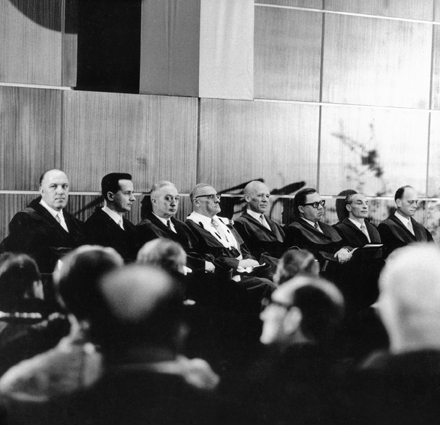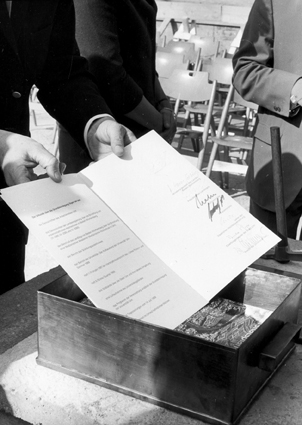Honours and awards
- Honorary citizens
- Honorary senators
- Honorary doctors, by faculties
- Medal recipients
‘Ulm will never ever be a university city,' stated Dr. Kurt Georg Kiesinger, State Premier of Baden-Württemberg at the time, in front of 40 teachers from Ulm who had come together in the state parliament building on 20 July 1961.
Just under six years later, on 25 February 1967, Kiesinger, who was the Chancellor of Germany by then, joined Founding Rector Prof. Ludwig Heilmeyer together with the new State Premier Dr. Hans Filbinger for the foundation ceremony of the Medizinisch-Naturwissenschaftliche Hochschule Ulm (higher education institution for medicine and natural sciences). On 4 July of the same year, the institution was given the official status of a university. Just under six years later, on 25 February 1967, Kiesinger, who was the Chancellor of Germany by then, joined Founding Rector Prof. Ludwig Heilmeyer together with the new State Premier Dr. Hans Filbinger for the foundation ceremony of the Medizinisch-Naturwissenschaftliche Hochschule Ulm (higher education institution for medicine and natural sciences). On 4 July of the same year, the institution was given the official status of a university.
'Never say never!' (original: Sag niemals nie!)
was the title of Ulm journalist Barbara Schäuffelen's chronology published in 2003 – a detailed account of the bumpy road from the initial stages to the memorable ceremonial act held at the Kornhaus. The apt and telling subtitle: 'How defiance got Ulm its university' (original: Wie sich die Ulmer ihre Universität ertrotzten)
Without question a fascinating and, as the author puts it, 'unique history in post-war Germany.' A central factor: The Task Force Ulm University – a citizens’ initiative established in the late 1950s, which fought for several years to get Ulm its own university. They were greatly supported by the local press and also by local politicians early on.
A reform concept for a higher education institution for medicine and natural sciences developed by Heilmeyer, who eventually became founding rector, was what ultimately persuaded the state parliament. His concept was received with great respect if not enthusiasm, particularly by renowned medical experts in the USA and at Harvard University, among others
'A rejection would have been an embarrassment for the entire country,' Barbara Schäuffelen asserts.
Despite ambitious expansion plans, the combination of subjects that was offered during the foundation phase shaped the academic profile of the young university for many years to come: Medicine, Biology, Chemistry, Physics and Mathematics.
In the realm of research, however, the individual disciplines and their institutions at large benefited soon from the foundation concept of a 'university under one roof', meaning intensive interdisciplinary collaboration.
Meanwhile, the physical realisation had to wait until the move into the first new buildings on campus in the early till mid-1970s. This facilitated the expansion of the traditional study programmes with innovative subjects or specialities. In 1977, for example, the combined discipline of Mathematics and Management was developed in Ulm and continues to be extremely successful to this day.
With the addition of Engineering and Computer Science, Economics and lastly Psychology, Ulm University managed to create a highly attractive portfolio.
Ulm University is driven by student demand on the one hand, but also strives to meet the requirements and needs of our society and economy. Two decades ago, however, the University made a conscious decision to move away from its long-standing goal of becoming a full-spectrum university in the traditional sense, for obvious reasons.
<link en study study-at-ulm-university study-programmes external link in new>Course catalogue of Ulm University
The most visible and for the further expansion most important step was the integration of the University into the 'Science City Ulm' at the end of the 1980s and early 1990s.
The University assumed and maintains a central and driving role and successively initiated the establishment of numerous public and industrial research and development institutions in its immediate environment, most of which collaborate closely with the University.
With technology transfer as the original primary goal – meaning faster conversion of research results into usable and marketable product – both sides have been benefiting from the development at the northern outskirts of Ulm: Students enjoy an abundance of opportunities for internships and final theses while graduates have attractive job prospects in the immediate vicinity.
Awarding scientists from the research institutes with professorships and teaching contracts integrates the latest results and experiences into the teaching and education. By no means is this limited to the structural landmark of this expansion phase, the Uni West building, which is primarily home to the engineering disciplines. At the same time, the extension process that took place on the nearly 1.6-kilometres-long and almost one-kilometre-wide premises has influenced the structural change of the city – in a direct way by creating thousands of new jobs with a promising future, and indirectly through the resulting purchasing power and its influences on the development of the city's infrastructure.
Today, over four decades after its foundation, the University has maintained a convenient size yet is alive and renowned for its strong research profile and high teaching standards.
It also offers an attractive course catalogue with a range of nationally and internationally recognised special study offers. The University continues to embrace its role as academic education institution for the region and has adapted itself, possibly easier than many others, to the significant changes in higher education.

